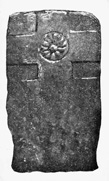Select a site alphabetically from the choices shown in the box below. Alternatively, browse sculptural examples using the Forward/Back buttons.
Chapters for this volume, along with copies of original in-text images, are available here.
Object type: Grave-marker
Measurements: measurements (after Martindale 1905) H. 37 cm (14.5 in); W. 21.5 cm (8.5 in); D. 7.5 cm (3 in)
Stone type: (after Martindale 1905) 'Local red sandstone'
Plate numbers in printed volume: 612 - 13
Corpus volume reference: Vol 2 p. 162
(There may be more views or larger images available for this item. Click on the thumbnail image to view.)
The slab was rectangular and carved at the upper end only. The lower section was presumably sunk into the ground.
A (broad): A cross, type A1, is carved in low relief from the background. Its horizontal arms are longer than the vertical. In the centre surrounded by an incised line is a rosette with a plan raised centre.
B and D (narrow): Plain(?).
C (broad): A cross of the same type as in face A but with a bold double ring carved in relief in the centre.
Appendix A item (stones dating from Saxo-Norman overlap period or of uncertain date).
Such simple monuments are impossible to date accurately, and the form of the cross is not diagnostic. Rosette ornament and bold central rings for cross centres can be found in pre-Conquest work (for example at Hexham, Northumberland, nos. 8, 9, and 15 (Cramp 1984, pls. 172, 910; 178, 944; 179, 955)). However, elaborate built-up rosettes also occur on later Cumbrian pieces such as Cumwhitton 1. One must therefore place this late in the pre-Conquest period, or shortly after the Conquest.



